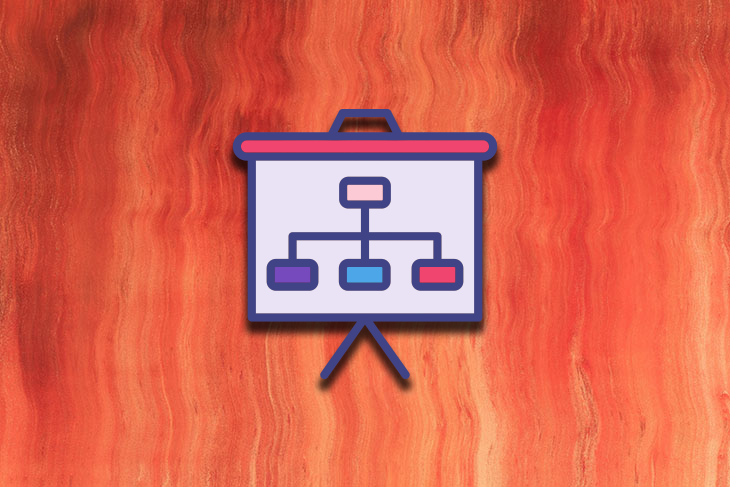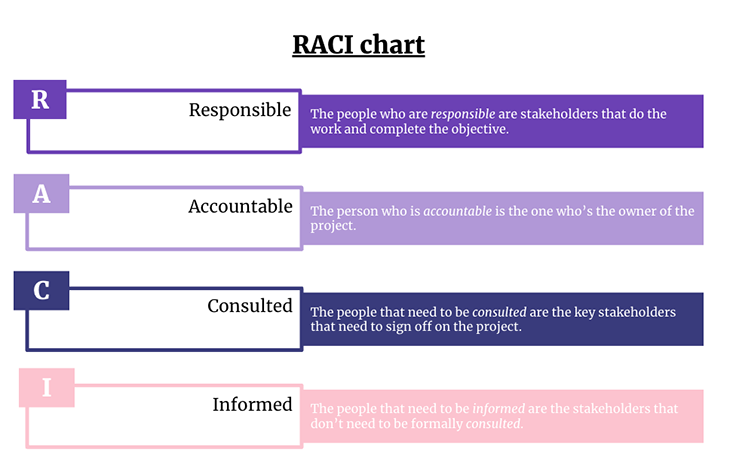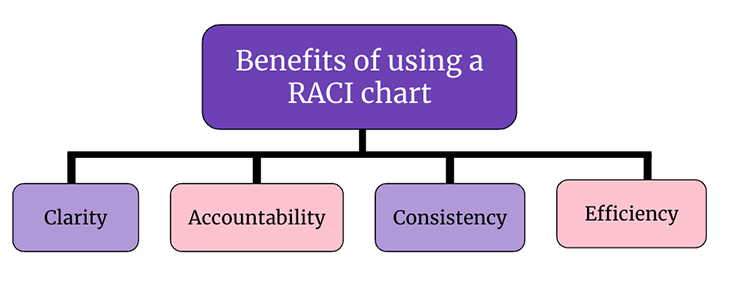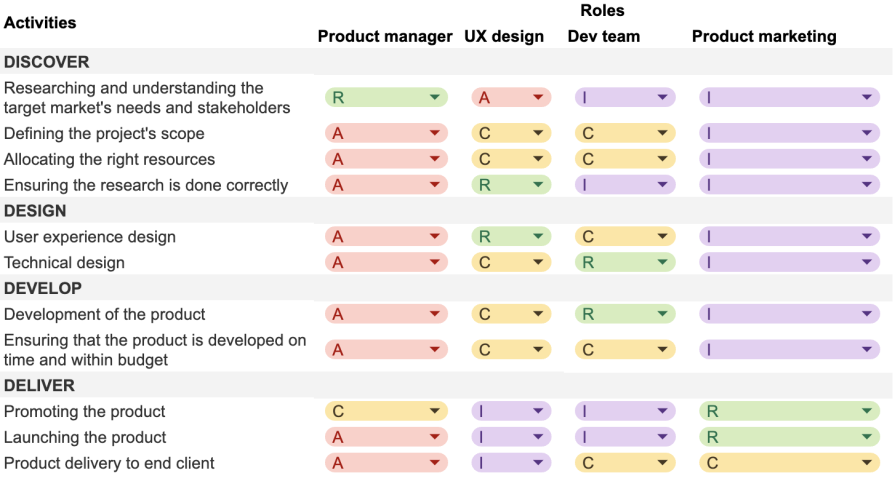Editor’s note: This article was updated by the author on 19 March 2025 to explain the different types of RACI roles, provide a step-by-step guide to creating a RACI chart, and answer FAQs.

Product work requires complex thinking and collaboration between multiple stakeholders and departments. Because of this, organizational tools like a responsibility assignment matrix — aka a RACI chart — can be helpful. RACI charts provide you with a detailed process for analyzing your specific context so that you can define a way of working and understand the responsibilities required to achieve your desired product outcome.
While originally a project management tool, this article explores how you can use RACI charts with your product team to align and manage dependencies and expectations.
A RACI chart, or responsibility assignment matrix, is a tool that helps you communicate and clarify the roles and responsibilities of people working together. In product management, it adds support for alignment and communication in the product development process by breaking team members into four distinct categories:

A RACI chart is a great tool to help you work together with your team and stakeholders. Some of the biggest benefits include:

One of the most common misunderstandings with the RACI chart is the distinction between the responsible and accountable roles.
The easiest way to look at it is to consider who’s performing the task:
For example, you might be accountable for a product team’s results, while individual team members are responsible for performing said tasks.
The table below provides an overview over the two roles:
| Aspect | Responsible (R) | Accountable (A) |
| Definition | Executes the task | Owns the task and ensures it is completed successfully |
| Role | Can be multiple people | Only one person |
| Authority | Follows direction and guidelines | Has decision-making power |
To create your first RACI chart, follow these key steps:
You can apply the RACI chart to the different stages of the product development process. To help you get started, consider how you could use it in tandem with 4D methodology (discover, design, develop, and deliver) to showcase how responsibilities can be split between product management, UX design, development team, and product marketing.
Depending on your context, you may also include a delivery manager, who’ll take over some of your responsibilities:

As the product manager, you’re responsible for researching and understanding the target market’s needs and stakeholders. You’re also accountable for defining the project’s scope, allocating the right resources, and ensuring the research is done correctly.
The UX designer and development team are consulted for input and feedback on the user experience and technical feasibility.
Product marketing will be informed of the findings.
The UX designer is responsible for the user experience, while the architect/technical lead is responsible for the technical design.
You’re accountable for ensuring that the design meets the requirements defined in the discovery stage, that the design is feasible, and that resources are allocated appropriately.
The development team will be consulted for input and feedback on the technical feasibility.
Product marketing is merely informed at this stage as well.
The development team is responsible for implementing the design and creating the product.
As the PM, you’re accountable for ensuring that the product is developed on time and within budget and for managing any issues that arise during development.
The UX designer should be consulted for input and feedback on the user experience and any issues identified.
Product marketing is informed of the progress and status.
Product marketing is responsible for promoting and launching the product and informs of the product’s readiness for launch.
You’re responsible for product delivery to the end user or client and accountable for ensuring the product meets the requirements defined in the discovery stage, is ready to be delivered, and that any final issues get solved.
The development team is consulted for input and feedback on the technical feasibility and any issues identified.
UX design is informed about the progress and status.
Generally, the person accountable for a given stage will lead it and make the final decisions, while others are consulted and informed as appropriate.
Here is a RACI chart template that you can use to define your product team’s own RACI chart. The first tab contains the RACI chart example we went through above, while the second tab contains a blank template organized around the same two main columns:
Make a copy of the RACI template Google Sheet by clicking file at the top left and choosing make a copy from the dropdown, or by choosing download from the dropdown and selecting the file type. Then, add your tasks and define your roles and responsibilities to customize the sheet.
Here are a few pitfalls to look for when you’re considering working with a RACI chart:
The RACI chart is a living document — it evolves with your team or product. Because of this, it’s important to revisit it every time you experience a change. Even if no changes occur, you should review it once a quarter.
Situations to review your RACI chart include when:
The RACI chart is a handy communication tool. Creating a RACI chart and shoving it into a folder or a drawer will not help you in any way.
Since it’s a tool meant to increase alignment and transparency, you should ensure that every involved party is aware of it and has easy access. It’s also beneficial when onboarding new team members or stakeholders.
When creating or maintaining your RACI chart, pay attention to how the responsibilities are split and that there aren’t areas of overlap. You should, as a team, clearly define who holds the responsibility and avoid having it split between too many team members, as this may cause unnecessary overhead.
Delivering successful products is a marathon, not a sprint. Ensure that no team members are overloaded with too many responsible tasks. Discuss within your team and decide on a reasonable workload together, considering all their daily responsibilities. Should certain team members or roles have too many responsibilities, you must consider increasing your team or re-assign responsibilities.
For example, you may have a product manager who needs to keep an eye on the market, drive product-market fit, perform discovery activities, and support sales and marketing while also acting as the product owner for the development team.
This will lead to frustration due to the development team’s lack of a product manager, so it might be a good idea to consider bringing a dedicated product owner on board. This way, they’ll dedicate their full attention to the team, while the product manager can focus on the more strategic aspects of the product.
The following section outlines the most commonly asked questions about RACI charts:
RACI stands for accountable, responsible, consulted, and informed. These are all roles a person can take when working on a project.
RACI charts are helpful, especially at the beginning of a project or when you want to clarify roles between multiple stakeholders. They can also be beneficial in a complex environment where multiple teams have to work together.
Yes, you can download a Google Sheets template here.
Each RACI chart needs to have all tasks listed, as well as all stakeholders in a matrix format. For each task and each stakeholder, one of the four RACI roles needs to be assigned.
One of the most common mistakes is assigning multiple people as accountable for one task. It’s critical to only assign one accountable individual per task. Also, don’t forget to update your chart whenever changes happen in your team.
Yes, a person can have multiple roles in a RACI chart, but remember to always have just one person who has the accountable role for each task.
Alternatives include DACI charts (driver, approver, contributor, informed) or RAPID (recommend, agree, perform, input, decide) charts.
While RACI charts originate with traditional project management practices, they’re as valuable for product management. They’re lightweight, but still hold a lot of relevant information. They also increase transparency around roles and responsibilities and ease the onboarding process of new team members.
RACI charts are invaluable tools for aligning teams and solving cross-functional dependencies. Use our template to get started on one today.
Featured image source: IconScout

LogRocket identifies friction points in the user experience so you can make informed decisions about product and design changes that must happen to hit your goals.
With LogRocket, you can understand the scope of the issues affecting your product and prioritize the changes that need to be made. LogRocket simplifies workflows by allowing Engineering, Product, UX, and Design teams to work from the same data as you, eliminating any confusion about what needs to be done.
Get your teams on the same page — try LogRocket today.

Most teams fail at autonomy. Learn how clear rules help product teams move faster without micromanagement.

A practical framework for PMs to use AI in ideation without sacrificing judgment, strategy, or decision quality.

A practical five minute revenue estimation method to help product managers compare ideas, drop low impact features, and prioritize smarter.

A practical guide for PMs who want to stop being bottlenecks, delegate smarter, and lead teams effectively with a clear ownership framework.